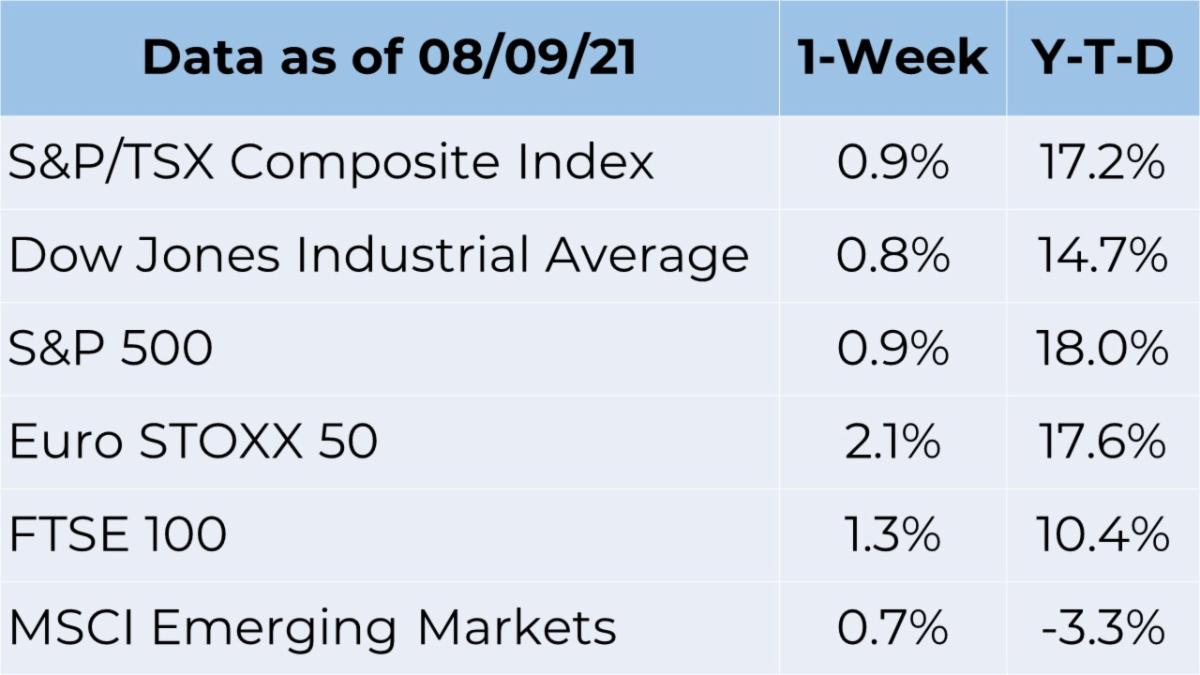Weekly Market Commentary - August 11th, 2021
The Markets
For months, investors have wondered when the U.S. Federal Reserve (“The Fed”) might begin to “normalize” its policies, a process that will eventually lead to higher interest rates. While the Fed does not control fiscal and monetary policy in Canada, we closely follow the decisions made by our southern neighbours as the Bank of Canada often follows suit with similar policy decisions. Last week, a better-than-expected unemployment report south of the border – showing a gain of almost a million jobs – sparked speculation about whether we’ve arrived at that normalization point. It’s difficult to know.
When the pandemic arrived, the Fed adopted policies that stimulated growth. It cut short-term interest rates to zero and began flooding the market with liquidity by buying Treasuries and agency mortgage-backed securities to keep long-term rates low, too. Low rates make borrowing less expensive for businesses and individuals, which can be particularly important in difficult times.
In late July, the Fed said it would continue to keep rates low and buy bonds until it saw “substantial further progress toward maximum employment and price stability [inflation] goals.”
The Fed may have already achieved its inflation goal. Its favorite inflation gauge is called Personal Consumption Expenditures (PCE), excluding food and energy. Changes to the value of the basket of goods used to calculate the PCE reflect changes in how much Americans are paying for goods and services (Here in Canada, we rely on a similar system, with our basket of goods being referred to as the “Consumer Price Index”, which also contains food). In June, the Bureau of Economic Analysis reported that PCE was up 3.5 percent year over year, similar to our own CPI, which rose 3.1 percent over the same period. That’s well above the central banks’ two percent inflation targets.
If July’s employment numbers satisfy the Fed’s expectations for progress on jobs, the Fed may begin the process of normalizing monetary policy. The first step would be purchasing fewer bonds, a practice known as tapering.
Major North American stock indices finished the week higher, as did the yield on 10-year U.S. Treasuries and Government of Canada bonds. If you have any questions or concerns about your investment portfolio or current market conditions, please don’t hesitate to give us a call.

Source: Refinitiv
If you haven't replied to our survey already, could you please spare three minutes of your day, we would love to hear from you.
What are your hobbies and interests? Would you attend an event focused on such topic? Click below and let us know

What's making the U.S. more productive?
While Canada continues to lag behind economically, even though the United States has not yet recovered all of the jobs lost during the pandemic – 22 million were lost and 16.6 million have returned – productivity is higher than it was pre-pandemic. The Economist reported:
“Though output reached a new high in the second quarter, employment remained more than 4 percent below its pre-pandemic level. At present, America is producing more output than it managed just a year and a half ago, with roughly 6 [million] fewer workers.”
Higher productivity undoubtedly reflects the ingenuity of American businesses. The pandemic forced companies to find ways to remain productive. In response, many adopted new technologies, implemented new patterns for working, and changed their business models.
However, not all companies have experienced gains in productivity, reported Eric Garton and Michael Mankins in the Harvard Business Review. Those that proved to be the best at managing time, talent and energy – the top 25 percent of companies – were 40 percent more productive than other companies. (The productivity of companies in the lower quartiles was averaged to make the comparison.)
Not all sectors of the economy are equally productive, either. “The surge in output per worker also reflects the changing mix of the workforce. Employment in the leisure and hospitality industries, where productivity tends to be low, remains about 10 percent below the pre-pandemic level, compared to a 3 percent shortfall in the higher-productivity manufacturing sector,” reported The Economist. As less productive sectors recover, productivity may return to previous levels.
In the meantime, some employees have been wondering whether it’s necessary to return to the workplace when productivity has been high while they’ve been working remotely. In an early July survey conducted by The Conference Board, a majority (56 percent) of employees asked whether returning to the workplace was wise, but just 18 percent of chief executive officers shared the concern.
Weekly Focus - Think About It
“Whenever you are asked if you can do a job, tell 'em, 'Certainly I can!' Then get busy and find out how to do it.”
—Theodore Roosevelt, 26th president of the United States
Best regards,
Eric Muir
B.Comm. (Hons.), CIM®, FCSI
Portfolio Manager
Tracey McDonald
FCSI, DMS, CIM®
Portfolio Manager

